See other History Articles
Title: Concentration Camp Money - 'Lagergeld' used to Pay Prisoners for Their Work
Source:
wintersonnenwende.com
URL Source: http://www.wintersonnenwende.com/sc ... archives/articles/ccmoney.html
Published: Jan 1, 2001
Author: Jennifer White
Post Date: 2006-09-23 18:44:11 by BTP Holdings
Keywords: None
Views: 217
Comments: 7
'Lagergeld' used to Pay Prisoners for Their Work Article from The Barnes Review, Jan./Feb. 2001, pp. 7-9. Far from being the "death camps" as you have heard so often, places like Auschwitz, Dachau and Buchenwald were not in the business of extermination. They were work camps, critical to the German war effort. But did you know that the Jewish workers were compensated for their labor with scrip printed specifically for their use in stores, canteens and even brothels? The prisoner monetary system was conceived in ghettos such as Lodz, carried to camps such as Auschwitz and Dachau and still existed in the displaced persons camps that were established by the Allies after World War II. Here is the story of the money the court historians do not want you to even suspect existed. Piles of incinerated corpses were indicting images at Nuremberg, used to prove that the German-run concentration camps during World War II were intended for purposes of exterminating the Jews of Europe. However, a plethora of documentary evidence, long suppressed, shows that prisoners were relatively well-treated, compensated for their hard work and allowed to purchase luxuries to which even the German public did not have ready access. This is not the image of abject deprivation that the Holocaust lobby would like you to entertain. The irrefutable proof is the existence of a means of exchange for goods and services: Money. There were at least 134 separate issues, in different denominations and styles, for such notorious places as Auschwitz, Buchenwald, Dachau, Oranienburg, Ravensbrück, Westerbork and at least 15 other camps. (See Paper Money of the World Part I: Modern Issues of Europe by Arnold Keller, Ph.D., 1956, pp. 23-25 for a complete listing.) A monetary system was also in existence in the ghettos, most notably Theresienstadt and Lodz, which produced beautiful notes (veritable works of art) that make U.S. currency look dull. There are numerous dealers in rare currency and numismatics who specialize in selling "concentration camp money" or "Holocaust money" as it has been sometimes called. But the very fact of its existence does not seem to have raised questions - as it should have - about what really did (and did not) happen inside the so-called "death camps" where the Holocaust scrip was circulating in the first place. This scrip was not negotiable outside of the camp for which it was issued. This decreased the chance of a successful escape and made it impossible for the general public to purchase some of the rare luxuries available in the camps. According to Albert Pick in Das Lagergeld der Konzentrations- und D.P.-Lager: 1933-1945: Letter from Prisoner No. 11647 Block 28/3 Dachau KIII on September 8, 1940 to his relative in Litzmannstadt (Lodz): There was a payment schedule at Theresienstadt utilizing Th. kr. (Theresienstadt kroner) as the unit of exchange. (The Shekel Vol. XVI, No. 2, March-April 1983 p. 29). The breakdown looked like this: To put this in perspective, a cup of coffee cost 2 Th. kr. The circulation in Theresienstadt was such that it was necessary to print over 5 million notes. See Papirove Penize Na Uzemi Ceskoslovenska 1762-1975, Second Edition, 1975, Hradek Kralove, trans. by Julius Sem, pp. 134-135. The first worker's camp to have its own scrip was Oranienburg. Before using the camp scrip they used German currency in nearby towns, but the authorities decided to centralize. Currency was exchanged for camp money, less 30%. (The Shekel, Vol XVI, No. 2, March-April 1983, p. 40: "Concentration Camp Money of the Nazi Holocaust" by Steven Feller.) Similarly at Buchenwald: Was there a similar situation at all of the other camps - at least those that issued currency? As this includes Auschwitz, it would be shocking indeed to even consider marmalade and cigarettes being purchased in this "death camp." Even the existence of money in camps gives us a look at what life was really like there, yet this information has yet to make it to the History Channel. Auschwitz Bibliography: American Israel Numismatic Association (Tamarac, Florida). Pick, Albert. Das Lagergeld der Konzentrations- und D.P.-Lager: 1933-1945, Munich, Battenberg Publishers, 1976. Schöne, Michael H., Das Papiergeld im besetzten Deutschland 1945-1949, Regenstauf: Gietl, 1994. Stahl, Zvi, Jewish Ghettos and Concentration Camps' Money, 1933-1945, London: D. Richman Books, 1990. See also: Campbell, Lance K., Dachau concentration camp scrip, Margate, Florida: American Israel Numismatic Association, 1992. The Numismatist, April 1981, by Steven Feller. Numismatic Scrapbook Magazine, 1965, 1996, "POW Money and Medals" by Slabaugh, R. Arlie. Schultze, Manfred, Unsere Arbeit - unsere Hoffnung: Das Ghetto in Lodz 1940-1945, Schwalmtal: Phil-Creativ, 1995. Sem, Julius, Standard Catalog of World Paper Money, 1977 (Theresienstadt notes). Shtarot, Vol. I, No. 2, Oct. 1976. Yasha L. Beresiner.
The Barnes Review, 645 Pennsylvania Ave SE, Suite 100, Washington D.C. 20003, USA.
By Jennifer White, administrative director of TBR;
published here with kind permission from TBR.
This digitalized version © 2001 by The Scriptorium.
eMail TBR - subscribe to TBR here
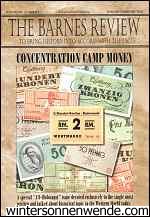
issue Jan.-Feb. 2001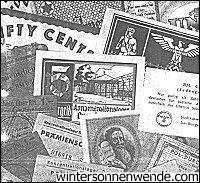
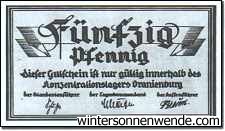
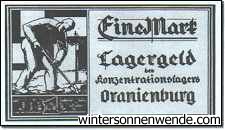
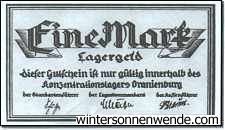
Inmates were not paid for the work but were given "coupons" now and then to buy things in the "Kantine".... As the war progressed badly and the number of workers declined, the KZ worker potential became important. Offers of "premiums" and other advantages were made to the inmates, tobacco was offered and even visits to bordellos.... In order that these scrips could not be used outside the camps, special money was printed.
I must write you something about myself. I am very well. In the canteen I buy honey, marmalade, cookies, fruit and other food. If you worry about me, you'll indeed be committing a sin. I have more reason to worry about you.... (Letters from the Doomed: Concentration Camp Correspondence 1940-1945, Richard S. Geehr.)
Working men, according to their jobs: 105-205 Th. kr.
Working women, according to their jobs: 95-205 Th. kr.
Part-time workers: 80 Th. kr.
Caretakers: 70 Th. kr.
War-wounded and holders of the Iron Cross, First Class degree or higher: 195 Th. kr.
Prominente (doctors, professors, scientists, well-known cultural artists and politicians): 145 Th. kr.Each prisoner was allowed up to 10 marks per week to be used for the purchase of cigarettes at the camp canteen, other canteen purchases, brothel visits, or credit to a savings account. The regulations went on to specify that a visit to a brothel would cost 2 marks for which 1.5 marks would be kept by the SS and 0.5 marks would be used for "expenses." (Ibid., p. 41.)
![]()
![]()
![]()
![]()
Infamous and Intricate Camp Money Dachau
"... [W]e must remember that like most other Concentration Camps, Dachau also functioned as a work camp. This explains the appearance of paper tokens printed in 1944.... Dachau's tokens were of three different values: 1, 2 and 3 marks. The prisoner's identification number is written on the front of this green note, alongside the date when it was issued, January 31, 1945. In fact, all of Dachau's tokens list the prisoner's identification numbers." Stahl, pp. 18- 19.
"At a death camp it would seem that there was very little need for money." (The Shekel, Vol. XVI, No. 2, March-April 1983, p. 43.) 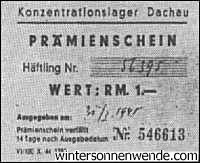
A Dachau camp note.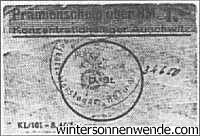
An Auschwitz camp note. Theresienstadt
Print runs for Theresienstadt Kroner Denomination
1 Th. kr.
2 Th. kr.
5 Th. kr.
10 Th. kr.
20 Th. kr.
50 Th. kr.
100 Th. kr. Size
100 x 50 mm
110 x 55 mm
120 x 58 mm
125 x 63 mm
135 x 66 mm
140 x 77 mm
150 x 77 mm Color
Green
Rose
Blue
Brown
Green
Dk. Green
Red-brownQty Printed
2,242,000
1,019,000
530,000
456,000
319,000
159,000
279,000 See: The Shekel Vol. XVI, No. 2, March/April 1983, p. 33. ![]()
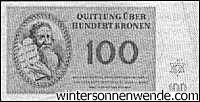
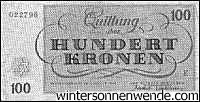
These beautiful Theresienstadt notes, complete with watermarks, demonstrate the high-quality artwork and printing of the money. ![]()
Lodz
Colors of the different types of currency in Lodz.
In print runs in 1940, 1942 and 1944:
50 Pfg. Violet
1 RM Olive-green
2 RM Light Brown
5 RM Dark Brown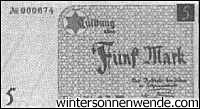
Lodz ghetto money. Information from Das Lagergeld der Konzentrations- und D.P.-Lager: 1933-1945
by Albert Pick and Carl Siemsen.
Post Comment Private Reply Ignore Thread
Top • Page Up • Full Thread • Page Down • Bottom/Latest
Begin Trace Mode for Comment # 1.
#1. To: Eoghan, AngelSpawn. Max, Itisa1mosttoolate, SKYDRIFTER, Diana, christine, Peetie Wheatstraw, ..., Dakmar, aristeides, Arator, HOUNDDAWG, bluedogtxn, robin, Brian S, noone222, It Is A Republic, Uncle Bill, Mekons4, Kamala, Jethro Tull, Red Jones, ruthie (#0)
PING!
There are no replies to Comment # 1. End Trace Mode for Comment # 1.
Top • Page Up • Full Thread • Page Down • Bottom/Latest
Replies to Comment # 1.